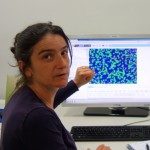Link to Pubmed [PMID] – 12151333
EMBO Rep. 2002 Aug;3(8):747-52
White-mottled (w(m4)) position-effect variegation (PEV) arises by translocation of the white gene near the pericentric AT-rich 1.688 g/cm3 satellite III (SATIII) repeats of the X chromosome of Drosophila. The natural and artificial A*T-hook proteins D1 and MATH20 modify w(m4) PEV in opposite ways. D1 binds SATIII repeats and enhances PEV, presumably via a recruitment of protein partners, whereas MATH20 suppresses it. We show that D1 and MATH20 compete for binding to identical sites of SATIII repeats in vitro and that conditional MATH20 expression results in a displacement of D1 from pericentric heterochromatin in vivo. In the presence of intermediate levels of MATH20, we show that this displacement becomes selective for SATIII repeats. These results strongly suggest that the suppression of w(m4) PEV by MATH20 is due to a displacement of D1 from its preferred binding sites and provide additional support for a direct role of D1 in the assembly of AT-rich heterochromatin.

